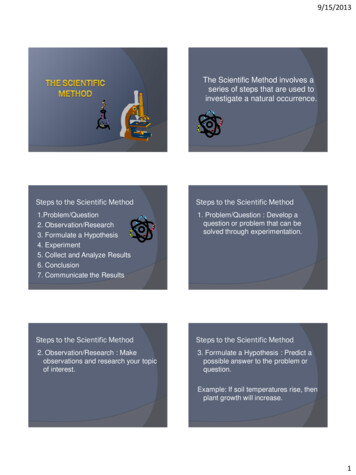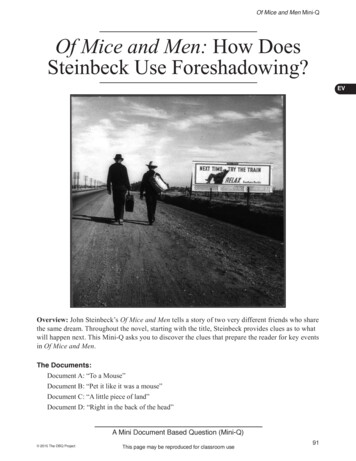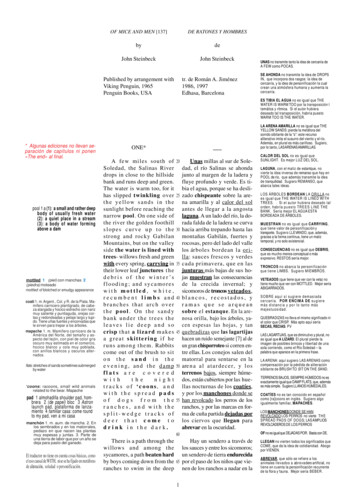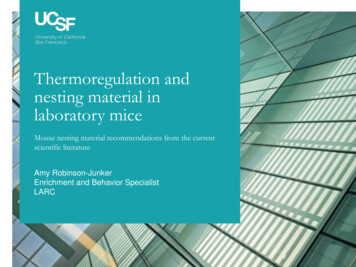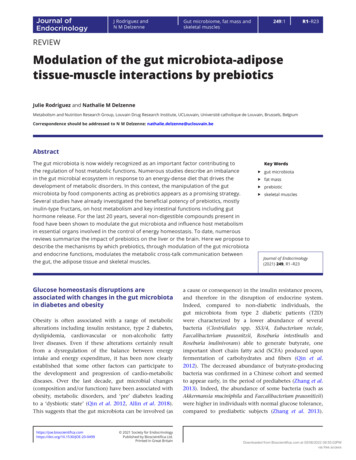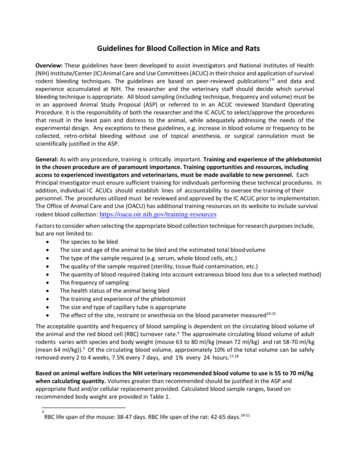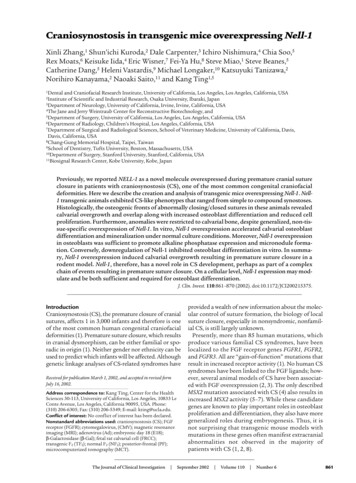
Transcription
Craniosynostosis in transgenic mice overexpressing Nell-1Xinli Zhang,1 Shun’ichi Kuroda,2 Dale Carpenter,3 Ichiro Nishimura,4 Chia Soo,5Rex Moats,6 Keisuke Iida,4 Eric Wisner,7 Fei-Ya Hu,8 Steve Miao,1 Steve Beanes,5Catherine Dang,5 Heleni Vastardis,9 Michael Longaker,10 Katsuyuki Tanizawa,2Norihiro Kanayama,2 Naoaki Saito,11 and Kang Ting1,51Dentaland Craniofacial Research Institute, University of California, Los Angeles, Los Angeles, California, USAof Scientific and Industrial Research, Osaka University, Ibaraki, Japan3Department of Neurology, University of California, Irvine, Irvine, California, USA4The Jane and Jerry Weintraub Center for Reconstructive Biotechnology, and5Department of Surgery, University of California, Los Angeles, Los Angeles, California, USA6Department of Radiology, Children’s Hospital, Los Angeles, California, USA7Department of Surgical and Radiological Sciences, School of Veterinary Medicine, University of California, Davis,Davis, California, USA8Chang-Gung Memorial Hospital, Taipei, Taiwan9School of Dentistry, Tufts University, Boston, Massachusetts, USA10Department of Surgery, Stanford University, Stanford, California, USA11Biosignal Research Center, Kobe University, Kobe, Japan2InstitutePreviously, we reported NELL-1 as a novel molecule overexpressed during premature cranial sutureclosure in patients with craniosynostosis (CS), one of the most common congenital craniofacialdeformities. Here we describe the creation and analysis of transgenic mice overexpressing Nell-1. Nell1 transgenic animals exhibited CS-like phenotypes that ranged from simple to compound synostoses.Histologically, the osteogenic fronts of abnormally closing/closed sutures in these animals revealedcalvarial overgrowth and overlap along with increased osteoblast differentiation and reduced cellproliferation. Furthermore, anomalies were restricted to calvarial bone, despite generalized, non-tissue-specific overexpression of Nell-1. In vitro, Nell-1 overexpression accelerated calvarial osteoblastdifferentiation and mineralization under normal culture conditions. Moreover, Nell-1 overexpressionin osteoblasts was sufficient to promote alkaline phosphatase expression and micronodule formation. Conversely, downregulation of Nell-1 inhibited osteoblast differentiation in vitro. In summary, Nell-1 overexpression induced calvarial overgrowth resulting in premature suture closure in arodent model. Nell-1, therefore, has a novel role in CS development, perhaps as part of a complexchain of events resulting in premature suture closure. On a cellular level, Nell-1 expression may modulate and be both sufficient and required for osteoblast differentiation.J. Clin. Invest. 110:861–870 (2002). sis (CS), the premature closure of cranialsutures, affects 1 in 3,000 infants and therefore is oneof the most common human congenital craniofacialdeformities (1). Premature suture closure, which resultsin cranial dysmorphism, can be either familial or sporadic in origin (1). Neither gender nor ethnicity can beused to predict which infants will be affected. Althoughgenetic linkage analyses of CS-related syndromes haveReceived for publication March 1, 2002, and accepted in revised formJuly 16, 2002.Address correspondence to: Kang Ting, Center for the HealthSciences 30-113, University of California, Los Angeles, 10833 LeConte Avenue, Los Angeles, California 90095, USA. Phone:(310) 206-6305; Fax: (310) 206-5349; E-mail: kting@ucla.edu.Conflict of interest: No conflict of interest has been declared.Nonstandard abbreviations used: craniosynostosis (CS); FGFreceptor (FGFR); cytomegalovirus, (CMV); magnetic resonanceimaging (MRI); adenovirus (Ad); embryonic day 18 (E18);β-Galactosidase (β-Gal); fetal rat calvarial cell (FRCC);transgenic F2 (TF2); normal F2 (NF2); posterior-frontal (PF);microcomputerized tomography (MCT).The Journal of Clinical Investigation provided a wealth of new information about the molecular control of suture formation, the biology of localsuture closure, especially in nonsyndromic, nonfamilial CS, is still largely unknown.Presently, more than 85 human mutations, whichproduce various familial CS syndromes, have beenlocalized to the FGF receptor genes FGFR1, FGFR2,and FGFR3. All are “gain-of-function” mutations thatresult in increased receptor activity (1). No human CSsyndromes have been linked to the FGF ligands; however, several animal models of CS have been associated with FGF overexpression (2, 3). The only describedMSX2 mutation associated with CS (4) also results inincreased MSX2 activity (5–7). While these candidategenes are known to play important roles in osteoblastproliferation and differentiation, they also have moregeneralized roles during embryogenesis. Thus, it isnot surprising that transgenic mouse models withmutations in these genes often manifest extracranialabnormalities not observed in the majority ofpatients with CS (1, 2, 8).September 2002 Volume 110 Number 6861
Premature suture closure in human CS can be divided into two possibly distinct processes: calvarial overgrowth and bony fusion. While calvarial overgrowthmay be essential to bringing the two opposingosteogenic fronts into proximity in order to inducebony fusion, it does not necessarily follow that calvarial overgrowth or overlap alone will result in bonyfusion. Thus, the study of premature suture closuremechanisms must include study of both abnormalsuture overgrowth/overlap and bony fusion (6).Recently, FGF2 and FGFR1 have been implicated inpremature cranial suture fusion via CBFA1-mediatedpathways (8). Missense mutation of CBFA1 is linked tocleidocranial dysplasia, manifested as delayed sutureclosure (9). Therefore, examination of Cbfa1 (Runx2), adownstream target of Fgfr1 that is essential for boneformation, may be key to understanding the signalingcascade in CS. In addition, Msx2, a member of the highly conserved Msx homeobox gene family withpleiotropic effects in development, has been implicated in an animal model of CS (5, 6). Specifically,increased osteogenic cell proliferation has been proposed as a mechanism for premature suture closure inMsx2-overexpressing transgenic mice, which exhibitsuture overgrowth/overlap without suture fusion.To elucidate the molecular pathway for suture closure,we previously used differential display to identify genesthat were specifically upregulated within abnormallyfused sutures in patients with nonfamilial, nonsyndromic CS. We isolated and characterized NELL-1, whichis a Nel-like, type 1 molecule (a protein strongly expressedin neural tissue, encoding an EGF-like domain) (10–12).Nell-1 is a secreted protein. Structurally, Nell-1 encodes asecretory signal peptide sequence, an NH2-terminalthrombospondin-1–like module, five von Willebrand factor–like repeats with six cysteine residues, and six EGFlike domains. Nell-1 is also highly conserved acrossspecies. For example, 93% amino acid sequence homology exists between rat Nell-1 and human NELL-1.Nell-1 encodes a polypeptide with a molecular weightof 90 kDa. When overexpressed in COS cells, the glycosylated form is N-linked to a 50-kDa carbohydrate moiety in eukaryotic cells to generate the 140-kDa formfound in the cytoplasm. This 140-kDa protein is further processed to a 130-kDa protein. The Nell-1 proteinis secreted as a trimeric form with a high molecularweight (approximately 400 kDa) (13, 14).Initial studies have suggested that NELL-1 is preferentially expressed in the craniofacial region of calvarial tissues (12–14). Premature suture closure in CS patients isremarkable for the degree of NELL-1 overexpression byosteoblast-like cells in osteogenic areas (12). AlthoughNELL-1 overexpression and premature suture closure maybe coincidental findings, our data suggest that NELL-1may be a local regulatory factor in cranial suture closure.In this study, we further verified that Nell-1 has a role inCS. We created a transgenic mouse model exhibiting generalized Nell-1 overexpression. Nell-1 transgenic animalsshare many of the same features as humans with CS. They862The Journal of Clinical Investigation demonstrate calvarial overgrowth/overlap and prematuresuture closure. Infection of osteoblasts with Nell-1 adenoviral constructs showed that Nell-1 promotes and accelerates differentiation in osteoblast lineage cells. In addition, Nell-1 downregulation inhibited osteoblast differentiation. Nell-1, therefore, represents a candidate gene forproducing cranial suture closure and provides newinsights in the study of CS and craniofacial development.MethodsPreparation of transgenic mice overexpressing Nell-1. RatNell-1 cDNA was subcloned from pTM-70 (13, 14) intopCDNA1.1 (Invitrogen, Carlsbad, California, USA),which uses a CMV promoter and an SV40 polyadenylation site. The recombinant plasmid was first transfected into MC3T3 cells (a mouse calvarial cell line) toverify proper protein expression (data not shown). The4.76-kb DNA fragment containing the CMV promoter,Nell-1 cDNA, and the SV40 polyadenylation site wasthen used for microinjection of oocytes. B6C3 micewere used to generate transgenic mice using standardprotocols (15). The founders were mated with theirnontransgenic littermates to set up transgenic lines.Analysis of transgene copy number. Transgene copy numbers were estimated by PCR and Southern blot analysis. The PCR protocol of establishing transgene copynumber was obtained at http://www.med.umich.edu/tamc/spike.html (16). The mass of transgene DNA per5 µg genomic DNA was calculated as N bp transgeneDNA/3 109 genomic DNA, based on the assumptionthat the haploid content of a mammalian genome is3 109 bp and that it takes 10 µg DNA to spike. Thesize of the insert is 4.76 kb, and the one-copy standardis 7.933 pg per 10 µg genomic DNA. Thirty cycles ofPCR were performed and products were separated onelectrophoresis gels with ethidium bromide. The intensities were calculated using Eagle Eye II (Stratagene, LaJolla, California, USA).Immunohistochemistry. Detailed preparation of Nell-1antibody has been documented by Kuroda et al. (13, 14).The antibody recognizes the COOH-terminal region ofNell-1 (CSVDLECIENN). The specificity of the antibodywas confirmed by Western blot using protein extractedfrom Nell-1–transfected NIH3T3 cells. A standard avidinbiotin complex/immunoperoxidase protocol (VectorElite Kit; Vector Laboratories Inc., Burlingame, California, USA) was used with 1:100 Nell-1 antibody dilution.Diaminobenzidine peroxidase substrate and 3-amino-9ethylcarbazole were used for visualization, and sectionswere counterstained with hematoxylin.Magnetic resonance imaging. Magnetic resonance imaging (MRI) was performed on formalin-preserved specimens using a Bruker Biospec MR imager (BrukerBioSpin GmbH, Rheinstetten, Germany) with a 7.0-T,18-cm clear-bore magnet equipped with a microimaging gradient set and a 35-mm internal diameter birdcage radiofrequency coil. Transaxial and sagittal imagesof the brain and calvarium were obtained using a gradient echo filtered imaging steady-state pulse sequenceSeptember 2002 Volume 110 Number 6
with the following parameters: TR/TE, 229.3/64.1 ms;flip angle, 30 ; field of view, 2.3 cm; matrix, 256 256;slice thickness, 1 mm; and number of excitations, 8. Inplane spatial resolution was approximately 90 µm.Microcomputerized tomography scan. All the data werecollected at 30 kVp and 750 mA. The data was reconstructed using the cone-beam algorithm supplied withthe MicroCat scanner (Oak Ridge National Laboratory, Oak Ridge, Tennessee, USA). The matrix was 256 256 256, yielding an isotropic resolution of 140 µm.The quantitative procedures involve the placement ofbone phantoms (long rods in the images) containing 0,50, 250, and 750 mg/cc hydroxyapatite. Visualizationof the data was performed using MetaMorph (twodimensional) (Universal Imaging Corp., West Chester,Pennsylvania, USA) and Amira (three dimensional)(Indeed – Visual Concepts GmbH, Berlin, Germany).In vivo proliferation analysis. Newborn mice were injected with BrdU at 100 µg/g. Animals were sacrificed 2hours after injection. The animals were fixed andimmunostained with BrdU antibodies (Sigma-Aldrich,St. Louis, Missouri, USA). Calvarial sutures, brain, andtibiae from transgenic animals and their normal littermates were compared.Recombinant defective adenovirus vectors harboring Nell-1(AdNell-1) and antisense Nell-1 (AdAntiNell-1). Rat Nell-1cDNA was inserted bidirectionally between the humanCMV IE1 promoter and the SV40 splice/polyadenylation site flanked by nucleotide sequences from 1 to 454and from 3,334 to 6,231 of the Ad5 virus. The resultingplasmid, pAdCMV-Nell-1, transcribes Nell-1 leftward relative to the standard Ad5 map. The recombinant adenovirus (Ad) (AdNell-1) were isolated by cotransfecting293 cells with pAdCMV-Nell-1 and pJM17 (MicrobixBiosystems Inc., Toronto, Canada), resulting in vectorsdefective in the E1-A viral gene. Clones of recombinantvirus were plaque purified and confirmed by Southernblot analysis. Both AdNell-1 and AdLacZ were grown toa high titer and purified once through a CsCl cushionand again on a continuous CsCl gradient. The resulting stocks were 5 109 pfu/ml as assayed by plaque formation on 293 cells. Northern and Western blots wereperformed to assure the incorporation and expressionof the Nell-1 gene and its protein product.Rat calvarial primary cell cultures (FRCCs). The isolationof osteogenic cells from embryonic day 18 (E18) rat calvaria was performed as previously described (12). Thecells collected from digestions four, five, and six werepooled and plated at 2.5 104/cm2. Cells within passage two were used.Adenoviral infection of osteoblasts. In order to observe theeffects of overexpressing Nell-1, osteoblasts from different lineages were grown to 80% confluence in six-wellplates. The media was aspirated and an infective dose(20 pfu/cell in 1 ml serum-free medium) was added tothe cultures. Five sets of AdNell-1, AdAntiNell-1, and control Ad carrying β-Galactosidase (Adβ-Gal) were used.On days 12, 15, and 21 after infection, von Kossa staining was performed. The percentage of area mineralizedThe Journal of Clinical Investigation was analyzed using the Image-Pro Plus system (MediaCybernetics, Silver Spring, Maryland, USA). Comparisons between mice were made using the Student t test.In order to observe the effects of downregulatingNell-1, AdAntiNell-1 was added to fetal rat calvarial cell(FRCC) cultures as described above.Microarray analysis. Microarrays were performed usingRNA from AdNell-1– and Adβ-Gal–infected MC3T3 cellsat 6, 9, and 12 days after infection. I. Nishimura and theUniversity of California Los Angeles Microarrays CoreFacility staff have developed bone-related microarrays.The microarrays contain over 37 genes with more thanten internal control genes. Confirmed markers includethe following: bone matrix proteins (osteopontin,osteonectin, osteocalcin, bone sialoprotein); receptors(α2-integrin, vitamin D receptor, parathyroid receptor,estrogen receptor); osteoblastic markers (alkaline phosphatase, Cbfa1); adhesive proteins (fibronectin, chondroitin sulfate proteoglycan 1, decorin, tenascin, syndecan, laminin); metalloproteinases (matrix metalloproteinases 1 and 2); growth factors (Bmp2, Bmp7); fibrillarcollagens (collagens 1A1, 1A2, 3A1, 5A2, and 11A1); othercollagens (collagens 4A1, 6A1, 7A1, 10A1, and 15A1); andfibril-associated collagen with interrupted triple helices(FACITs) (collagens 9A1, 9A2, 12, 14, 16, and 19).RNA (30 µg total RNA for Cy3 and 60 µg for Cy5) waslabeled with random hexamer primers and Cy3- or Cy5dUTP. The reverse transcriptase–labeled probes werehybridized onto the arrays. Multiple laser scans wereperformed with a 418 Array Scanner (Affymetrix Inc.,Santa Clara, California, USA) to provide mean readoutsand standard deviations to verify the reproducibility ofthe measurements. An average of all the internal controls was calculated and used to normalize hybridization intensities using the IPLab version 3.2 MicroArraysuite (Scanalytics Inc., Fairfax, Virginia, USA). The correlation of all osteoblastic markers as a group was calculated and compared between the AdNell-1–infectedcells and the Adβ-Gal–infected control cells.RT-PCR. DNase-treated total RNA was used. After initial verification of gene fragment expression throughhigh-cycle PCR, another low-cycle PCR was performedto quantify relative gene expression (12). For each candidate molecule, we determined the cycle number mostlikely to fall within the linear amplification range bysuccessively reducing the number of cycles (range,15–35 cycles). Electrophoreses were performed andhybridized with sequence-specific probes labeled witP32. A PhosphorImager (Molecular Dynamics, Sunnyvale, California, USA) was used to measure the intensities. For each sample, the densitometry value was divided by the Gapdh value (performed at 20 cycles) andnormalized. Primer sequences were as follows. Msx2:forward, 5′-CCTCGGTCAAGTCGGAAAATTC-3′; reverse,5′-TGGACAGGTACTGTTTCTGGCG-3′; probe, 5′-GAGCACCGTGGATACAGGAG-3′ (annealing temperature,68 C). Cbfa1: forward, 5′-CTGTGTGGCTCCTAACAAGTGTG-3′; reverse, 5′-GGATTCTGGCAATCACAAGCTGTC3′; probe, 5′-CCTACTCACTGTCCGGGGAGTCCTGC-3′September 2002 Volume 110 Number 6863
Flow cytometry analysis. Cells were seeded on 60-mmplates at 5 105 cells/plate. Cells were harvested at 24,36, 48, and 72 hours after infection with AdNell-1 andAdβ-Gal. One million cells were used for flow cytometry, and this procedure was repeated three times. Hypotonic DNA staining buffer containing propidiumiodide was added to the cells for flow cytometry.Figure 1Nell-1 transgenic mice compared with nontransgenic littermates. (a)Transgene copy number. The founders (FA and FB) and their progeny(TF2A1, TF2A2, and TF2B1) have copy numbers between 50 and 100.TF2A1 and TF2A2 are from the founder A line. TF2B1, TF2B2, andTF2B3 are from the founder B line. (b) RT-PCR analyses of Nell-1 RNAexpression in both founders. C, control Nell-1 plasmid; M, muscle; H,heart; B, bone; K, kidney; L, liver. (c) Whole body (without head) RNAof newborn progeny. TF2A1 and TF2A2 express different levels ofNell-1. TF2B1 expresses Nell-1 weakly, while TF2B2 and TF2B3 have noNell-1 expression. (d) Left panels, immunolocalization of Nell-1 protein in newborn NF2 epithelium, muscle, and calvarial bone. There isno detectable Nell-1 expression (brown staining indicates the presenceof Nell-1) except some staining in the calvarial bone. Right panels,immunolocalization of Nell-1 protein in TF2A2 epithelium, muscle, andcalvarial bone. Abundant Nell-1 expression is present throughout allsoft tissue layers as well as in bone. Bar represents 50 µm.(annealing temperature, 66 C). Osteocalcin: forward,5′-ATGAGGACCCTCTCTCTGCTC-3′; reverse, 5′-GTGGTGCCATAGATGCGCTTG-3′; probe CATGTCAAGCAGGGAGGGCA-3′ (annealing temperature, 66 C).Osteopontin: forward, 5′-AGCAGGAATACTAACTGC-3′;reverse, 5′-GATTATAGTGACACAGAC-3′; probe 5′-GCCCTGAGCTTAGTTCGTTG-3′ (annealing temperature,66 C). Nell-1: (12).864The Journal of Clinical Investigation ResultsConstruction of CMV promoter/Nell-1 transgenic mice. Toinvestigate the effects of generalized Nell-1 overexpressionin vivo, transgenic mice in which Nell-1 is expressed underthe control of the CMV promoter were produced. Copynumber was confirmed by Southern blot and PCR (Figure 1a). RNA analysis (Figure 1b) and immunohistochemistry (data not shown) further confirmed expressionof Nell-1 in founders. Nell-1–overexpressing founderswere crossed with nontransgenic littermates, and comprehensive analyses were conducted on F2 progeny.Because most human CS phenotypes are readily apparent in newborns, 42 newborn mice, representing six litters from two lines, were examined. The morphology ofthese mice was assessed for developmental anomalies,including suture closure. The mice were subsequentlygenotyped. Suture patency was determined by theabsence (indicating suture closure) or the presence (indicating suture patency) of visible blood vessels underneaththe suture. Suture closure was further confirmed undera dissecting microscope. Two of the six litters examined,representing 20 progeny, did not yield any newborns withobvious craniofacial defects and were Nell-1 transgenenegative. These litters were not examined further. Progeny with craniofacial defects were recovered in each of thefour remaining litters. The progeny of these four litters(22 mice) were analyzed further. A limitation of this rapidscreening method is that mild CS with only focal pointsof suture closure may not be detected, and therefore Nell-1overexpression might appear to have lower penetrance.Thirteen (60%) of the 22 newborn progeny were transgenic, with gene copy numbers similar to the founderNell-1 mice (prediction is 50%). Nell-1 RNA levels of the 13Nell-1 DNA–positive transgenic F2 (TF2) mice were examined. Eight (62%) were positive for Nell-1 RNA expression.However, the level of expression varied (Figure 1c). Thereason for low or nearly absent Nell-1 expression in someTF2 mice despite their high transgene copy numbers isnot clear, but epigenetic effects such as heterochromatinformation around the inserts may play a significant rolein the high variability of transgene expression (17). RNAlevels also differed in different tissues isolated from thesame litter. Liu et al. also made this observation of variegation when they overexpressed Msx2 using a CMV promoter (5, 6). Therefore transgenic Nell-1 transcriptionmay not necessarily correlate with gene copy number, andmay also vary according to cell type.To determine whether Nell-1 overexpression in ourtransgenic model was physiologically relevant, we compared Nell-1 RNA expression levels from the whole headsof three TF2 progeny with mild CS phenotypes to levelsSeptember 2002 Volume 110 Number 6
in nontransgenic normal littermates (NF2 mice). TF2mice displayed up to fourfold-increased Nell-1 expression(data not shown). This was comparable to levels ofNELL-1 overexpression in human CS patients in whomtwo- to fourfold increases have been observed (12). Thissuggests that Nell-1 overexpression levels in our modelwere clinically relevant rather than superphysiologic.Phenotypic analyses of Nell-1 transgenic mice. Three of theeight Nell-1 RNA-positive TF2 mice demonstrated severecraniofacial anomalies and died shortly after birth (seeFigure 2, a–c, and Figure 4). These mice also demonstrated detectable Nell-1 transgene expression in theirtotal body mRNA (Figure 1c) that was verified by Nell-1immunostaining of skin, liver, and calvaria (Figure 1d).Morphological examination of one of the mostseverely affected TF2 mice revealed a large protuberancein the paramedial parietal area with completely closedsagittal and posterior-frontal (PF) sutures and partially closed coronal sutures (Figure 2, a–c). Clinically, thisis similar to craniotelencephalic dysplasia, a form ofhuman CS with premature sagittal, metopic, and coronal suture closure with secondary frontal bone bossingand paramedial encephalocele (Figure 2d) (1). BrainMRI of this TF2 mouse revealed significantly reducedventricle size and increased parenchymal edema, bothof which are suggestive of increased intracranial pressures (Figure 2e). Continued brain growth in the faceof premature suture closure also generates increasedintracranial pressures in humans with untreated CS.Microcomputerized tomography (MCT) scan and MRIanalysis also demonstrated structural abnormalities inthe cranium of this TF2 mouse (Figure 2, f and g).Histological examination of Nell-1 phenotype-positiveTF2 mice revealed distinct differences from NF2 littermates. As in human CS, TF2 mice displayed prematurelyclosing sutures seen histologically as thickened, disorganized ridges of calvarial ridges with closing/overlapping osteogenic fronts (Figure 3, a and b). Whole-mountskeletal staining did not show any observable extracranialskeletal anomalies. Hematoxylin and eosin and tartrateresistant acid phosphatase staining of palatal and midmandible sutures, vertebrae, and long bones did notreveal any abnormal histology or increase in osteoclastnumber. Therefore, the effects of Nell-1 expressionappear to be confined to the calvaria. Despite pan-tissueNell-1 expression due to the use of the CMV promoter, TF2mice exhibited cranial-specific anomalies that primarilyaffected calvarial suture patency and closure. Immunohistochemistry showed increased in vivo expression ofosteoblastic differentiation markers (Figure 3, c and d).In situ BrdU analysis of prematurely closing cranialsutures in Nell-1–expressing TF2 mice demonstratedsignificantly reduced numbers of proliferating cellswithin osteogenic areas along suture edges (Figure 3, eand f). These data suggest that Nell-1 overexpression isassociated with osteoblast differentiation. No statistically significant difference was observed in the totalnumber (Figure 3g) of cells per field along the suturesof TF2 and NF2 mice. The observed decrease in proliferating cells may be secondary to the decreased proliferative abilities of differentiated osteoblasts or mayreflect a primary defect in osteoblast proliferation.Morphologic examination of a second severely affected TF2 animal showed significant cranial sutureFigure 2Phenotypic evaluation of Nell-1 transgenic mice. (a and b)Left panels show a newborn Nell-1 phenotype–positive(TF2A1) mouse. Note the protrusion in the frontoparietalarea (arrows). Right panels show an NF2 littermate. (c) Leftpanel, TF2A2 mouse with the scalp removed. The sagittal(yellow arrow) and PF (black arrow) sutures are closed. Rightpanel, skull of the NF2 littermate with patent sagittal (yellowarrows) and PF (black arrow) sutures and normal vasculature underneath the patent sutures. (d) An infant with craniotelencephalic dysplasia, a severe form of CS. (e) Brain MRIof TF2A1 mouse (left) and NF2 littermate (right). Note thecomplete absence of ventricles, suggesting elevated intracranial pressure in the TF2A1 mouse (arrows, left) relative to itsNF2 littermate (arrows, right). (f) MCT-reconstructed threedimensional skull views of the newborn Nell-1 phenotypepositive TF2A1 (left) and NF2 (right) littermates. Arrows indicate sagittal and PF suture sites. In TF2A1 mice, the sagittaland PF sutures are largely closed and replaced with an abnormal ridge. In the NF2 littermate, both sagittal and PF suturesare patent. Complete opacity corresponds to greater than 50mg/cc mineralization. The vertical rods in the backgroundare phantom reference rods corresponding to mineralizationdensities (from left to right) of 50, 100, 150, and 200 mg/cc.(g) Serial axial MCT sections of the TF2A1 (left) and NF2 littermates (right) shown in f. Yellow arrows indicate the distortion of the cranium. Green arrows indicate increased mineralization of the calvarium in the TF2A mouse (arrow, right).The Journal of Clinical Investigation September 2002 Volume 110 Number 6865
Figure 3Histologic and immunohistologic evaluation of Nell-1 transgenicmice. (a) Hematoxylin and eosin staining of the sagittal suture of aNell-1 phenotype-positive TF2A1 mouse. There is closure of thesuture, shown by the overlap of calvarial edges (black arrows) andclosing osteogenic fronts (red arrows). Lower left panel shows vonKossa staining. Note the close proximity of mineralized calvarialedges. (b) Hematoxylin and eosin staining of the sagittal suture froman NF2 littermate. Note the large distance separating the two calvarial edges (black arrows) at the patent suture site, as well as theadvancing osteogenic fronts (red arrows). Lower left panel showsvon Kossa staining. Black color indicates mineralization. (c)Immunolocalization of alkaline phosphatase (ALP) in a TF2A1mouse. Brown staining indicates the presence of alkaline phosphatase (arrows). Lower panel represents the immunolocalizationof osteopontin at lower magnification. (d) Upper panel showsimmunolocalization of alkaline phosphatase in newborn NF2 cranial suture. Lower panel represents the immunolocalization ofosteopontin (OP) at a lower magnification. Bar represents 50 µm.(e) BrdU staining of a TF2 sagittal suture. The nuclei of proliferatingcells are stained brown (black arrows). Proliferating cells are significantly decreased relative to those shown for NF2 in d. (f) BrdUstaining of a newborn NF2 mouse sagittal suture. Numerous brownstained cells are proliferating along the calvarial edges (blackarrows) of the patent suture, as well as along the advancingosteogenic fronts (red arrows). H&E, hematoxylin and eosin. (g)Number of proliferating cells per field.obliteration, primarily in the midline (i.e., sagittal andposterior frontal sutures), with bulging in the occipital(posterior) area. Overall, the skull was narrow andresembled those of humans with scaphocephaly andpremature sagittal synostosis. MCT scanning revealedcomplete PF suture and partial sagittal and coronal866The Journal of Clinical Investigation suture closure (Figure 4b). Histological correlationrevealed marked calvarial bone overgrowth and overlapin the closed area of the sagittal suture (Figure 4b).To examine TF2 embryologic development duringgestation, two litters of E15 TF2 progeny were sacrificed. Nonviable littermates with exencephaly-like phenotypes were observed in two of 19 embryos. Interestingly, Liu et al. reported a similar finding ofexencephaly for Msx2-overexpressing mice (6). The etiology for this phenotype is not clear. This result mayalso help to explain the observed low incidence ofseverely affected TF2 progeny among newborn mice.Overexpression of Nell-1 in vitro accelerates osteoblast differentiation. Dysregulated bone formation has been proposed as a possible mechanism for calvarial overgrowth/overlap and premature suture closure (18).Because abnormal suture site osteogenesis is the cardinalfeature of Nell-1 TF2 mice exhibiting premature sutureclosure, we hypothesized that Nell-1 overexpression
5Department of Surgery, University of California, Los Angeles, Los Angeles, California, USA 6Department of Radiology, Children's Hospital, Los Angeles, California, USA 7Department of Surgical and Radiological Sciences, School of Veterinary Medicine, University of California, Davis, Davis, California, USA 8Chang-Gung Memorial Hospital, Taipei .
